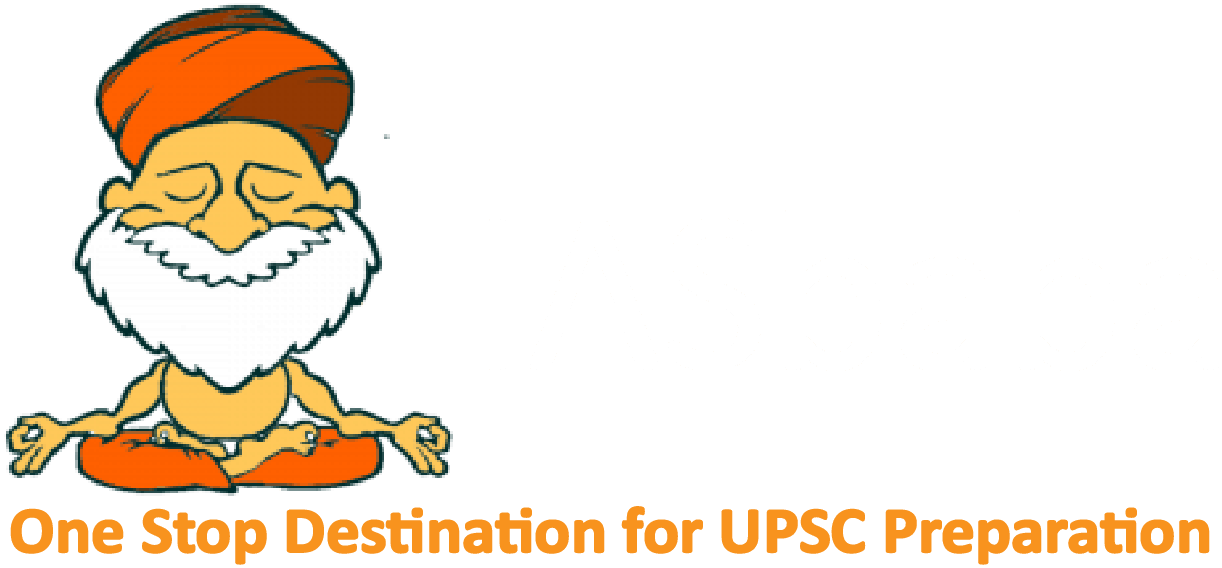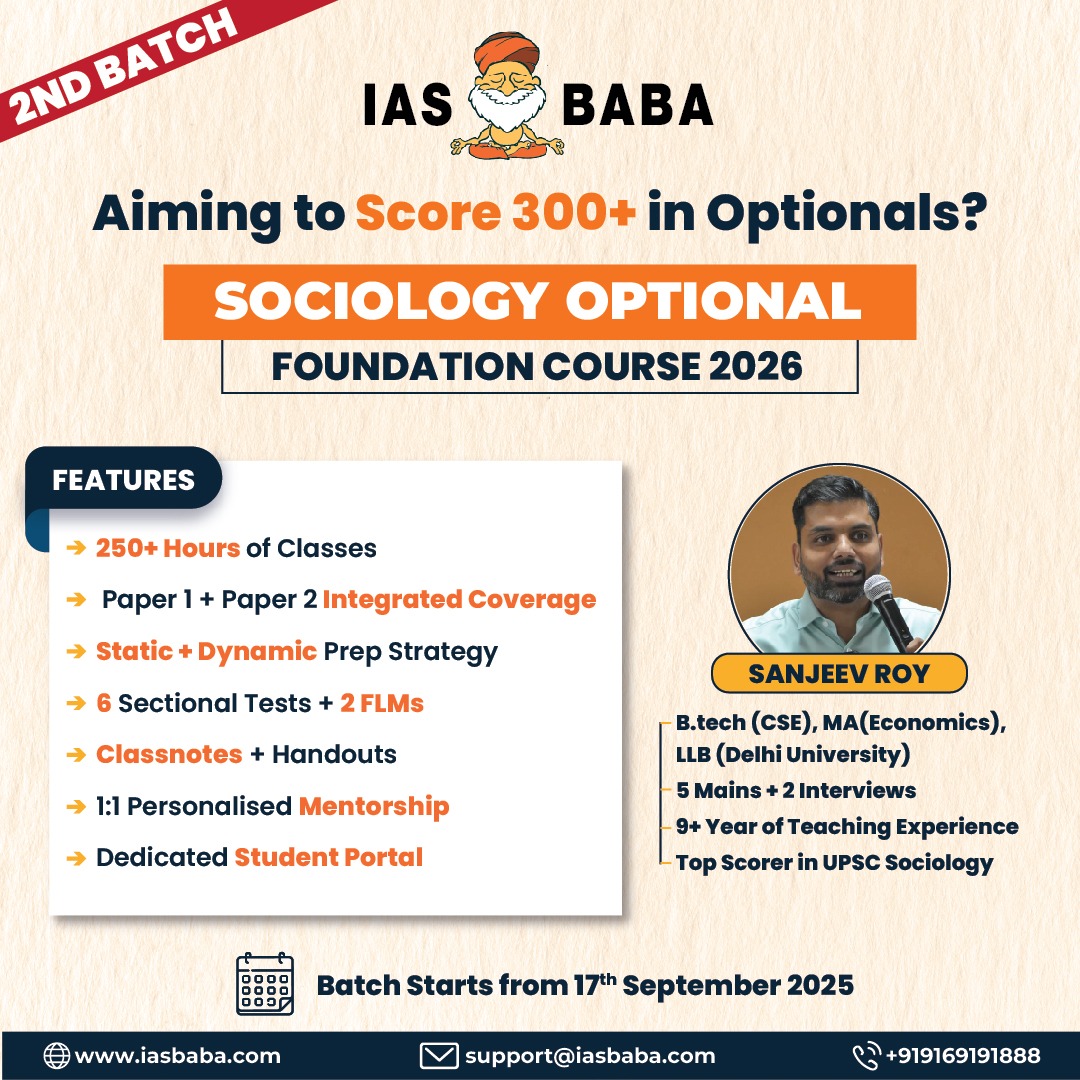IASbaba's Daily Current Affairs Analysis
rchives
(PRELIMS Focus)
Category: POLITY
Context: The Supreme Court of India has regained its full sanctioned strength of 34 judges with the swearing-in of Justices Alok Aradhe and Vipul M. Pancholi by Chief Justice B.R. Gavai.
Key Appointments
- Their induction restored the Court to full capacity.
- Justice Pancholi is in line to become Chief Justice of India in 2031, retiring in May 2033.
- The appointments were made by a 4:1 Collegium majority, with Justice B.V. Nagarathna dissenting over seniority concerns.
Background
- Justice Pancholi (b. 1968) started his career in Gujarat, became a Permanent Judge of Gujarat HC in 2016, and later Chief Justice of Patna HC in 2023.
- Justice Aradhe (b. 1964) began in Madhya Pradesh, became a Permanent Judge of MP HC, and was appointed Chief Justice of Bombay HC in 2023.
Appointment Process
- The move ensures full strength until Chief Justice Gavai’s retirement on November 23.
- Despite dissent, the appointments were cleared swiftly.
Learning Corner:
Constitutional Provisions
- Article 124(2): Judges of the Supreme Court are appointed by the President of India.
- The President consults judges of the Supreme Court and High Courts as deemed necessary.
- The Chief Justice of India (CJI) is appointed by convention on the basis of seniority.
- Retirement age: 65 years (Article 124).
Evolution of Appointment Process
- First Judges Case (S.P. Gupta v. Union of India, 1981)
- Held that the President had primacy in judicial appointments.
- “Consultation” with CJI did not mean “concurrence.”
- Second Judges Case (Supreme Court Advocates-on-Record Association v. Union of India, 1993)
- Overruled the First Judges Case.
- Gave primacy to the CJI’s opinion, formed with the two senior-most judges → birth of the Collegium System.
- Third Judges Case (1998, Presidential Reference)
- Expanded the Collegium to CJI + 4 senior-most judges.
- Made collective decision binding on appointments.
- Fourth Judges Case (NJAC Case, 2015)
- Struck down the 99th Constitutional Amendment and the National Judicial Appointments Commission (NJAC) as unconstitutional.
- Restored the Collegium System, citing judicial independence as part of the basic structure.
Current System (Collegium)
- CJI + 4 senior-most SC judges recommend names to the President.
- The Government can send back names for reconsideration once, but if re-recommended, it is binding.
Source: THE HINDU
Category: ENVIRONMENT
Context : The elusive Crocothemis erythraea dragonfly has been rediscovered in the high-altitude regions of the southern Western Ghats after decades of misidentification with the widespread Crocothemis servilia.
Key Points
- Field studies (2019–2023) confirmed that both species coexist in the Western Ghats.
- Earlier photographic evidence from Munnar faced scepticism, prompting detailed surveys.
- C. erythraea typically inhabits high elevations across Europe, Asia, and the Himalayas; its presence in southern India suggests migration during the Pleistocene Ice Age.
- The rediscovery underscores the Western Ghats’ role in conserving ancient insect lineages and biodiversity.
Source: THE HINDU
Category: INTERNATIONAL
Context: The Government of India has appointed Urjit Patel, former RBI Governor, as Executive Director at the IMF for a three-year term, succeeding K.V. Subramanian.
Key Details
- Patel will represent India in the IMF Executive Board’s four-country constituency with Bangladesh, Sri Lanka, and Bhutan.
- He previously served as RBI Governor (2016–2018), Deputy Governor, and Vice President at the Asian Infrastructure Investment Bank.
- His career includes roles at the IMF, Ministry of Finance, and leading corporations.
- He holds advanced economics degrees from LSE, Oxford, and Yale.
Learning Corner:
Overview
- The International Monetary Fund (IMF) is a specialized UN agency established in 1944 (Bretton Woods Conference) and formally came into existence in 1945.
- Headquarters: Washington, D.C., USA.
- Membership: 190 countries (as of 2025).
- India is a founding member.
Objectives
- Promote international monetary cooperation.
- Ensure exchange rate stability and orderly exchange arrangements.
- Facilitate balanced growth of international trade.
- Provide financial assistance to members facing balance of payments difficulties.
- Reduce global poverty through sustainable economic growth.
Structure
- Board of Governors: One governor from each member country (usually Finance Minister or Central Bank Governor).
- Executive Board: 24 Directors representing countries/constituencies; oversees day-to-day operations.
- Managing Director: Head of the IMF, traditionally a European.
- Quota System: Determines a member’s financial contribution, voting power, and access to financing.
Key Functions
- Surveillance: Monitoring global and country-level economic developments.
- Financial Assistance: Provides loans to members (e.g., Extended Fund Facility, Stand-By Arrangements).
- Capacity Development: Technical assistance and training in fiscal policy, monetary policy, and financial systems.
Important Facts for Exams
- India is part of a constituency with Bangladesh, Sri Lanka, and Bhutan.
- Special Drawing Rights (SDRs) act as IMF’s reserve asset.
- Major lending tool during crises: Stand-By Arrangements (SBA), Extended Fund Facility (EFF), Rapid Financing Instrument (RFI).
Source: THE HINDU
Category: POLITY
Context: The State Energy Efficiency Index (SEEI) 2024, released by the Bureau of Energy Efficiency (BEE)
Statewise Top Performers
- Maharashtra: Group 1 (>15 MToE)
- Andhra Pradesh: Group 2 (5–15 MToE)
- Assam: Group 3 (1–5 MToE)
- Tripura: Group 4 (<1 MToE)
Index Highlights
- Covers 36 States/UTs, with 66 indicators across sectors like buildings, industry, transport, agriculture, DISCOMs, and municipal services.
- Categories: Front Runners (>60%), Achievers (50–60%), Contenders (30–50%), Aspirants (<30%).
- Key reforms: Energy Conservation Building Code (24 states), EV policies (31 states), solar pumps (13 states, Kerala leads with 74%).
- All states/UTs have Energy Efficiency Action Plans; 31 set up State-Level Steering Committees on Energy Transition.
Learning Corner:
State Energy Efficiency Index (SEEI):
Overview
- The State Energy Efficiency Index (SEEI) is released by the Bureau of Energy Efficiency (BEE) in collaboration with the Alliance for an Energy Efficient Economy (AEEE).
- It tracks the progress of states and Union Territories in implementing energy efficiency policies and programs.
Objectives
- Evaluate state-level energy efficiency initiatives.
- Encourage peer-to-peer learning and healthy competition among states.
- Support India’s Nationally Determined Contributions (NDCs) and net-zero targets.
Coverage & Indicators
- Covers 36 States and UTs.
- Uses 66 indicators across key sectors:
- Buildings
- Industry
- Transport
- Agriculture
- Municipal services
- DISCOMs
- Cross-sector initiatives
Scoring & Categories
- States/UTs are scored and grouped into four categories:
- Front Runners: >60%
- Achievers: 50–60%
- Contenders: 30–50%
- Aspirants: <30%
Source: PIB
Category: CULTURE
Context: Nuakhai Festival 2025
Nuakhai is a major harvest festival celebrated primarily in Western Odisha and adjoining regions. It marks the first consumption of the season’s newly harvested rice and expresses gratitude to Mother Earth and farmers for a bountiful crop, the festival holds deep cultural and agrarian importance in districts like Sambalpur, Kalahandi, and Balangir. Families gather to seek blessings from elders, offer prayers, and participate in traditional dances and community feasts. It symbolizes unity, prosperity, and the strong bond between people and the land.
Learning Corner:
Major harvest festivals of India
| Festival | State/Region | Key Features |
|---|---|---|
| Nuakhai | Western Odisha, parts of Chhattisgarh, Jharkhand | Offering of new rice to Goddess Samaleswari; community feast & folk dance. |
| Onam | Kerala | 10-day festival; linked with King Mahabali’s homecoming; boat races, Pookalam (floral carpet). |
| Pongal | Tamil Nadu | 4-day festival; dedicated to Sun God; boiling of first rice (Pongal dish). |
| Makar Sankranti | Pan-India (esp. Gujarat, Maharashtra, Karnataka) | Kite flying, sesame sweets, Sun’s transition to Capricorn. |
| Baisakhi | Punjab, Haryana | Harvest of Rabi crop; also marks Sikh New Year and Khalsa Panth foundation. |
| Lohri | Punjab | Bonfire festival marking end of winter; sugarcane harvest celebration. |
| Magh Bihu (Bhogali Bihu) | Assam | Community feasts, Meji bonfire, post-harvest celebrations in January. |
| Kati Bihu | Assam | Lighting of lamps in paddy fields for crop protection. |
| Makaravilakku | Kerala (Sabarimala) | Linked to harvest and pilgrimage at Lord Ayyappa temple. |
| Poush Parbon | West Bengal | Celebration with Pithe-Puli (rice cakes) after paddy harvest. |
| Ugadi | Karnataka, Andhra Pradesh, Telangana | New Year & harvest festival; symbolic chutney with all tastes of life. |
| Gudi Padwa | Maharashtra | Marathi New Year & harvest festival; Gudi flag hoisted outside homes. |
| Vishu | Kerala | Harvest & New Year festival; Vishukkani ritual of auspicious sight. |
| Mithila’s Chhath | Bihar, Eastern UP | Sun God worship at river banks; tied to agrarian cycle. |
| Wangala | Meghalaya (Garo tribe) | 100-drum festival thanking Sun-God Saljong after harvest. |
| Ka Pomblang Nongkrem | Meghalaya (Khasi tribe) | Thanksgiving to Goddess Ka Blei Synshar for harvest. |
Source: PIB
(MAINS Focus)
Introduction (Context)
Every year, nearly 70 lakh students in India compete for limited undergraduate seats through entrance examinations such as JEE, NEET, CUET, and CLAT.
With demand far outstripping supply, these exams have fuelled an expanding coaching industry and a culture of relentless academic pressure.
The situation calls for an urgent rethinking of undergraduate admissions to prioritise fairness, equity, and student well-being.
Coaching industry and pressure
- Over 15 lakh students prepare for JEE alone.
- Coaching centres charge exorbitant fees (₹6–7 lakh for two years).
- Students as young as 14 enter a treadmill of problem-solving with advanced texts, leading to alienation, stress, and depression.
- Some governments have enacted laws to regulate coaching centres. Yet, the root issue lies in an entrance examination system that overqualifies students and distorts merit.
Issues with Current Entrance Examination System
- Around 15 lakh students compete for just 18,000+ IIT seats, making the competition extremely intense.
- The system tries to differentiate between students scoring 91% vs 97% in Class 12 or 99.5 vs 99.9 percentile in JEE, which is an unrealistic distinction.
- For pursuing a B.Tech degree, a decent Class 12 score of 70–80% in PCM subjects is already sufficient.
- Due to limited seats and uneven quality of colleges, students are forced to aim for extraordinary scores, creating a false sense of hierarchy.
- This process sidelined many capable students, especially those without access to costly coaching.
- It widens urban–rural, gender, and regional divides, favouring those with privilege.
Psychological and Social Consequences
- Psychologically, students suffer immense stress, depression, and burnout.
- Socially, the system benefits wealthier families who can afford elite coaching centres, giving an illusion of “merit.”
Philosopher Michael Sandel argues that this kind of meritocracy is toxic, as it ignores the role of luck and privilege.
To address such flaws, Sandel even suggests lotteries for admissions in top universities like Harvard and Stanford.
Global Inspirations
Dutch Lottery Model
- Weighted lottery in medical admissions (since 1972, reinstated in 2023).
- Students above a threshold enter a lottery; higher grades improve odds.
- Promotes diversity, reduces bias, and lessens pressure.
China’s “Double Reduction” Policy (2021)
- Banned for-profit tutoring in school subjects.
- Nationalised coaching to cut financial burden and protect youth well-being.
- Directly addressed issues of overgrowth and disorder in private coaching.
Steps needed
- Admissions should be simplified by trusting Class 12 board exams instead of multiple entrance tests.
- An eligibility threshold (e.g., 80% in Physics, Chemistry, and Mathematics) can be set for B.Tech admissions.
- Seats can be distributed through a weighted lottery system, where higher marks increase chances but all eligible students have a fair opportunity.
- The lottery system should also incorporate existing reservations for SC, ST, OBC, EWS, and other categories.
- To promote social mobility, 50% of IIT seats can be reserved for students from rural areas and government schools.
- Special weightage can be given to ensure gender and regional diversity within the system.
- The coaching culture should be curbed by either banning or nationalising commercial centres.
- The government should provide free online study materials, lectures, and mock tests for equal access to preparation.
- IITs can adopt student exchange programmes, allowing students to study at different campuses during their course.
- Professors should be rotated across IITs to maintain uniform standards and dismantle hierarchies among campuses.
- By reducing the burden of extreme competition, students can have more time for sports, creativity, peer bonding, and hobbies.
- The aim should be to allow youth to live a balanced adolescence, instead of becoming “percentile-chasing machines.”
Conclusion
India stands at a crossroads either to continue with a toxic, high-pressure race that scars students and society or adopt a fair, equitable, and student-centric system. Moving towards a lottery-cum-threshold model, inspired by global practices, can democratise access, reduce coaching dependence, and restore balance in education.
Mains Practice Question
Q The Indian entrance examination system has created a culture of excessive competition, inequity, and psychological strain. Critically examine the challenges of the current model and suggest reforms drawing from global best practices. (250 words, 15 marks)
Source: Detoxifying India’s entrance examination system – The Hindu
Introduction (Context)
India’s energy security is increasingly under strain due to its heavy dependence on imported hydrocarbons.
With over 85% of crude oil and 50% of natural gas sourced from abroad, represent a strategic vulnerability in times of geopolitical tensions, supply chain disruptions, and regional conflicts.
Recent incidents
Russia – Ukraine War
- Due to Russia-Ukraine war, supply got reduced in European nations.
- Russia emerging as India’s largest oil supplier since 2022.
- While discounted barrels have reduced the import bill, the over-reliance on a single geopolitical partner highlights the risks of substitution over diversification.
Israel – Iran tensions
- June 2025 Israel–Iran tensions brought the world dangerously close to a regional conflict that could have disrupted nearly 20 million barrels/day of oil flows.
- Brent crude prices were projected to cross $103/barrel had war broken out.
This outflow of foreign exchange pressures the rupee, inflates the trade deficit, and compromises macroeconomic stability.
Global Flashpoints that Reshaped Energy Security
The 1973 Oil Embargo
- In 1973, Arab countries stopped oil supply to the US and its allies.
- This led to crude oil prices becoming four times higher in a short time.
- It showed how dependent Western countries were on OPEC (Organization of Petroleum Exporting Countries).
- As a result, many countries started building strategic petroleum reserves, introduced energy efficiency rules, and looked for diverse suppliers.
The 2011 Fukushima Nuclear Disaster
- In Japan, a tsunami caused a nuclear power plant meltdown in Fukushima.
- This created a global fear of nuclear power and many countries reduced or shut down their nuclear plants.
- But as coal and gas use went up, carbon emissions increased.
- Now, due to climate concerns, many countries are again turning back to nuclear energy as a clean and stable source.
2021 Texas Freeze
- In the US state of Texas, extreme cold weather froze natural gas pipelines and even stopped some wind turbines.
- This caused a major power crisis in a state that is normally energy-rich.
- The incident showed that systems designed only for cost efficiency are not enough. Energy systems need to be resilient, weather-proof, and diversified.
Russia–Ukraine War
- Before the war, Europe got over 40% of its gas from Russia.
- When Russia used energy supplies as a weapon, Europe suddenly lost this access.
- Gas prices shot up, coal use increased again, and Europe rushed to buy LNG from other countries.
- Lesson: No country can be truly energy sovereign if it depends too heavily on a single supplier.
Iberian Peninsula Blackout
- In Spain and Portugal, the electricity grid collapsed due to over-reliance on renewables like wind and solar.
- There was not enough dispatchable backup power (like coal, gas, or nuclear plants).
- This exposed the danger of removing conventional capacity too quickly without creating strong storage systems.
Each of these crises forced the world to rethink energy policy. Energy systems must be diversified, resilient, and foresight-driven, not reactive.
Current Status of Global Energy transition
- Fossil fuels still meet over 80% of global primary energy demand.
- More than 90% of transportation runs on hydrocarbons.
- Solar and wind, though scaling fast, are still under 10% of the global energy mix.
- Exploration investments in oil and gas have fallen sharply even as demand remains high.
This all is leading to tightening of supply and raising volatility.
India’s Roadmap to Energy Sovereignty
India must now decisively move toward an energy sovereignty doctrine that is anchored in domestic capacity, diversified technology, and resilient systems. It has five foundational pillars.
Coal Gasification
- India has more than 150 billion tonnes of coal reserves.
- Earlier, these reserves were not used much because of high ash content.
- With new technologies like coal gasification and carbon capture, this coal can now be used better.
- It can help produce syngas, methanol, hydrogen, and fertilizers from domestic coal.
- To reduce import dependence, India must use innovation to overcome the ash problem and unlock this resource.
Biofuels
- Biofuels link rural development with national energy security. The ethanol blending programme has reduced crude oil imports, saving foreign exchange.
- With E20 (20% ethanol blending) coming soon, rural incomes are expected to rise further.
- Under the SATAT scheme, CBG plants produce clean fuel and nutrient-rich bio-manure, helping restore degraded soils in North India and improving water retention, fertilizer use, and reducing pollution.
Nuclear Energy
- India’s nuclear footprint has remained stagnant at 8.8 GW for too long.
- Must revive thorium roadmap, expand uranium partnerships, and invest in Small Modular Reactors (SMRs).
- Provides dispatchable baseload power in renewable-heavy grids.
Green Hydrogen
- India’s target is to generate green hydrogen of five million metric tonnes a year by 2030
- Requires domestic electrolyser manufacturing, catalysts, storage systems.
Pumped Hydro Storage
- Proven, durable, and critical for balancing intermittent renewables.
- India’s topography suitable for large pumped storage projects.
- Provides grid inertia and stability missing in solar/wind-heavy systems.
Terminologies
- Pumped Hydro Storage – A method of storing energy by pumping water to a higher reservoir during low electricity demand and releasing it through turbines to generate power when demand is high, providing grid stability and renewable energy backup.
- Green Hydrogen – Hydrogen produced using renewable energy sources like solar or wind through water electrolysis, offering a clean, carbon-free fuel alternative for industry, transport, and power generation.
- Biofuels – Fuels derived from organic matter such as crops, waste, or algae, including ethanol and biodiesel, which can replace or supplement conventional fossil fuels while supporting rural economies.
- Small Modular Reactors (SMRs) – Compact nuclear reactors designed for modular construction, offering flexible, scalable, and safer nuclear power with lower upfront costs compared to traditional large reactors.
- SATAT Scheme – Sustainable Alternative Towards Affordable Transportation initiative that promotes setting up compressed biogas (CBG) plants to produce clean fuel and bio-manure, enhancing rural energy and soil health.
- Ethanol Blending Programme – A government scheme to mix ethanol with petrol (like E10 or E20) to reduce oil imports, lower emissions, and increase farmers’ income through higher demand for sugarcane and other feedstocks.
- Coal Gasification – A technology that converts coal into synthetic gas (syngas) containing hydrogen, carbon monoxide, and other products, which can be used for power, chemicals, or fuel, while reducing reliance on imports.
Conclusion
India’s energy future depends on securing affordable, uninterrupted, and indigenous energy. Over-reliance on imports or single suppliers makes the country vulnerable to global shocks. By focusing on coal gasification, biofuels, nuclear energy, green hydrogen, and pumped hydro storage, India can build a resilient, diversified, and sovereign energy system. Acting now with foresight will ensure energy security, economic stability, and long-term strategic independence.
Mains Practice Question
Q “Energy sovereignty is more important than energy transition for India’s national security.” Examine. (250 words, 15 marks)














